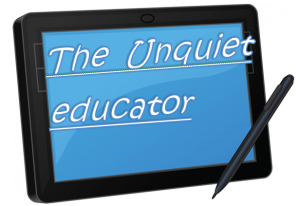iED Europe Summit Paris 2012 | iED Europe
Via Scoop.it – SchooL-i-Tecs 101
2nd European Immersive Education Summit
26th and 27th November 2012
École nationale supérieure des Arts Décoratif EnsAD (Paris, France)
There is a growing interest in the use of virtual and mixed-reality environments for online teaching and learning. Immersive Education gives participants a sense of “being there” even when attending a class or training session in person isn’t possible, practical, or desirable, which in turn provides educators and students with the ability to connect and communicate in a way that greatly enhances the learning experience. Originally available only to university students, the next generation of Immersive Education is focused on a broad spectrum of academic and non-academic users (higher education, K-12, and corporate training).
iED Summits are official Immersive Education Initiative conferences organized specifically for educators, researchers, and administrators. iED Summits consist of presentations, panel discussions, break-out sessions and workshops that provide attendees with an in-depth overview of immersive learning platforms, technologies and cutting-edge research from around the world. iED Summits feature new and emerging virtual worlds, learning games, educational simulations, mixed/augmented reality, and related teaching tools, techniques, technologies, standards and best practices….
The Unquiet Educator Part 1
 It all has to do with the degree of determination, commitment and critical thinking. If you have your resources well organised – RSS feeds, discussion groups, twitter- then time will never again be an issue.
It all has to do with the degree of determination, commitment and critical thinking. If you have your resources well organised – RSS feeds, discussion groups, twitter- then time will never again be an issue.
Information, tools, advice, professional development opportunities are out there for you to grasp. Provided you’ve developed a selection, screening and feedback process, you will eventually be shielded against a lot of frustration and waste of time.
A few kickstarter tips can make the difference:
- Start with a LinkedIn Profile. We’ll be surprised how the resumé builder process will help you refocus on your strengths and weaknesses and rethink where you would like to be in terms of qualifications, experience and practice. You’ll also have the amazing opportunity of interacting with other professionals and profit from their expert opinions and advice.
- Sign up in Twitter
 and search for the relevant to your professional field hashtags like #edtech, #edreform #learning, #education etc, and start following people or organisations actively involved in that field. You’ll be amazed of how much relevant info you’ll soon be getting.
and search for the relevant to your professional field hashtags like #edtech, #edreform #learning, #education etc, and start following people or organisations actively involved in that field. You’ll be amazed of how much relevant info you’ll soon be getting. - Search for educational news, institutes, magazines, higherEd blogs and progressively build up your RSS aggregator such as Bloglines.com that, on a daily basis, will be bringing to you all that’s fresh and current in your area of interest.
- Start a LiveBinder
 and by using the Livebinder it bookmarklet on your browser bar everytime you come across a site that’s worth showcasing just press the key!!! There will soon be a whale of useful resources for you to share with students and colleagues.
and by using the Livebinder it bookmarklet on your browser bar everytime you come across a site that’s worth showcasing just press the key!!! There will soon be a whale of useful resources for you to share with students and colleagues. - Start a Scoop.it curation topic. By tapping on the scoop.it bookmarklet installed on your browser bar you’ll be able to put together a great theme magazine for your class to enjoy and work on!!!
- Start an edublog or website (wordpress, weebly, edublogs, google sites…). Even if your school doesn’t have an LMS yet where student to student and teacher to student interactions can take place facilitating the learning process, enhancing student progress, making learning edtech integration engaging and fun, even for the most technology reluctant education community members, the design and implementation of such a project through active participation and contributions will soon be proven beneficial to all.
- Don’t forget about the opportunities that QR codes educational use has brought to the profession. I personally consider QR codes an intriguing and cunning way to make students get involved!! By taking advantage of their inherit curiosity, you can set up a lot of projects, resources for them to explore with a simple smartphone. Explore all the possibilities.
- Don’t neglect the power of image over young people. Engaging 3-minute presentations, videos, slideshows can make a world of difference. Youtube, brainshark, slideshare, screenr are just a few places where you can upload your productions to share with your class.
So, sleeves up and Connect, Aggregate, Curate, Interact.
8 Ways Teachers and Students Can Use Google+
Via Scoop.it – SchooL-i-Tecs 101
A reminder of some great Google+ features for classroom use…
Ed Leaders Meet for the ASU SkySong Ed Innovation Summit
Via Scoop.it – SchooL-i-Tecs 101
Education leaders meet in Scottsdale, AZ April 16-18, 2012 for the Education Innovation Summit 12, hosted by Arizona State University (ASU) SkySong, to discuss major trends in personalized and adaptive learning, new models for delivering education…
Generation Z: The Biggest Cheaters Since Homer
Via Scoop.it – SchooL-i-Tecs 101
The Information Age and digital era in general have reshaped our lives, the way we do things, the way we think. Even the notion of cheating and what it means to cheat has changed. In education, academic idealism has collided with GenZ realism. Beliefs in student integrity and cheating are at odds with the abundance of information and the speed of content delivery.
TED Blog | April 16: Watch a TED session live online from Doha, Qatar
Via Scoop.it – SchooL-i-Tecs 101
Next week, in Doha, Qatar, they’re launching a four-day-long workshop called TEDxSummit — where 700 TEDx organizers from around the world will meet to take classes and learn from one another how to make great local TEDx events.
And to kick off the summit, they will be throwing a session of TED — and inviting the world to watch live!
5 Ways Education Could Be Revolutionized Over the Next 20 Years | Edudemic
Via Scoop.it – SchooL-i-Tecs 101
Over the next twenty years, within an increasingly global economy, better technology, less public funding for schools, and more diversity, education will change dramatically. In this post, Sofia Rasmussen explores five areas in education that will be altered in the next two decades…
How Android Tablets Could Fit Into Your Classroom
Via Scoop.it – SchooL-i-Tecs 101
With Android tablets, students can research right at their desk or even watch a relevant curriculum video. The best part is that students can do this all at their own pace. Teachers will find themselves with fewer students falling behind and fewer students bored as they wait for the lesson to progress. The benefits of having web-accessible tablets in the classroom are endless.
Android eReaders would be advantageous in any curriculum. The days of crowding a classroom with bulky books are over with these inexpensive eReaders. Students can use them for in-class reading assignments or just for something for them to do if they finish their work early.
Read more in this enlightening post by Justin Craig…

















